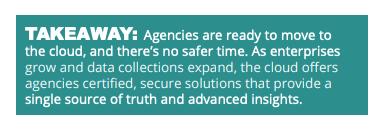This blog post is an excerpt from GovLoop’s recent guide “7 Tips to Transform Your Data Into Compelling Stories.” Download the full guide here.
When you hear the term “national security,” you might think of large boardrooms, world maps and mission defense systems. But clichés are just a small part of the story.
Instead, national security comes in many forms, all relating to public safety, and many of them rest with data. Vulnerable data can compromise the identity of individuals and corporations, risking financial or personal harm. Meanwhile, data without visibility or without pipelines can fail to make its way through government, for instance, not delivering important insights that could stop a terrorist attack. These responsibilities deal with more than the Intelligence Community and defense agencies; they fall on the shoulders of every agency.
GovLoop spoke with David Bargh, Solution Manager for SAP Analytics Cloud at SAP National Security Services (NS2), to talk about the centrality of data to national security and government operations. NS2 offers a wide array of analytic solutions that can help government agencies create a data environment conducive to security, productivity and interoperability.
“It’s not just about the data. It’s about the cybersecurity, the collaboration, how agencies and private sector coordinate and have transparency between each other,” Bargh said.
For example, the Food and Drug Administration (FDA) Adverse Event Reporting System stores information submitted about adverse events, faulty medication and product quality complaints, pinpointing safety hazards not noticed in testing. Without the right analytics, important findings might not be discovered in a timely fashion, or at all.
“They said, ‘If we don’t get this right, people die,’” Bargh said about FDA.
With advanced analytical tools, FDA is able to discover dangerous linkages, such as an unhealthy combination of medicines. With this information, department employees can issue warnings or take products off the shelves.
A variety of analytical tools, including cloud-based analytics and capabilities, enable these sorts of insights. The advantage of the cloud is that it tears down silos, promotes standardization and generates insights for analysts and business leaders alike. Analytics coming from the cloud result in agencies working from a single source of truth, allowing for greater collaboration and faster action.

In addition to advanced analytics tools, SAP NS2 offers Qualtrics solutions, which provide a constant human feedback mechanism illuminating the “why” for decisions or results. When agencies enable intelligent business enterprise in the cloud, they are enabling employees to deliver more efficient and personalized customer service.
And, because of important governmentwide security programs such as FedRAMP, agencies are able to move data out of aging data centers into environments secured for modern-day risks and attacks.
The public sector has a responsibility to keep data secure. In the cloud, government can do just that, all the while gaining modern insights to fuel decision-making and service provision.






Couldn’t agree more with what Bargh said about the importance of collaboration—data sharing is key to driving insights in government.